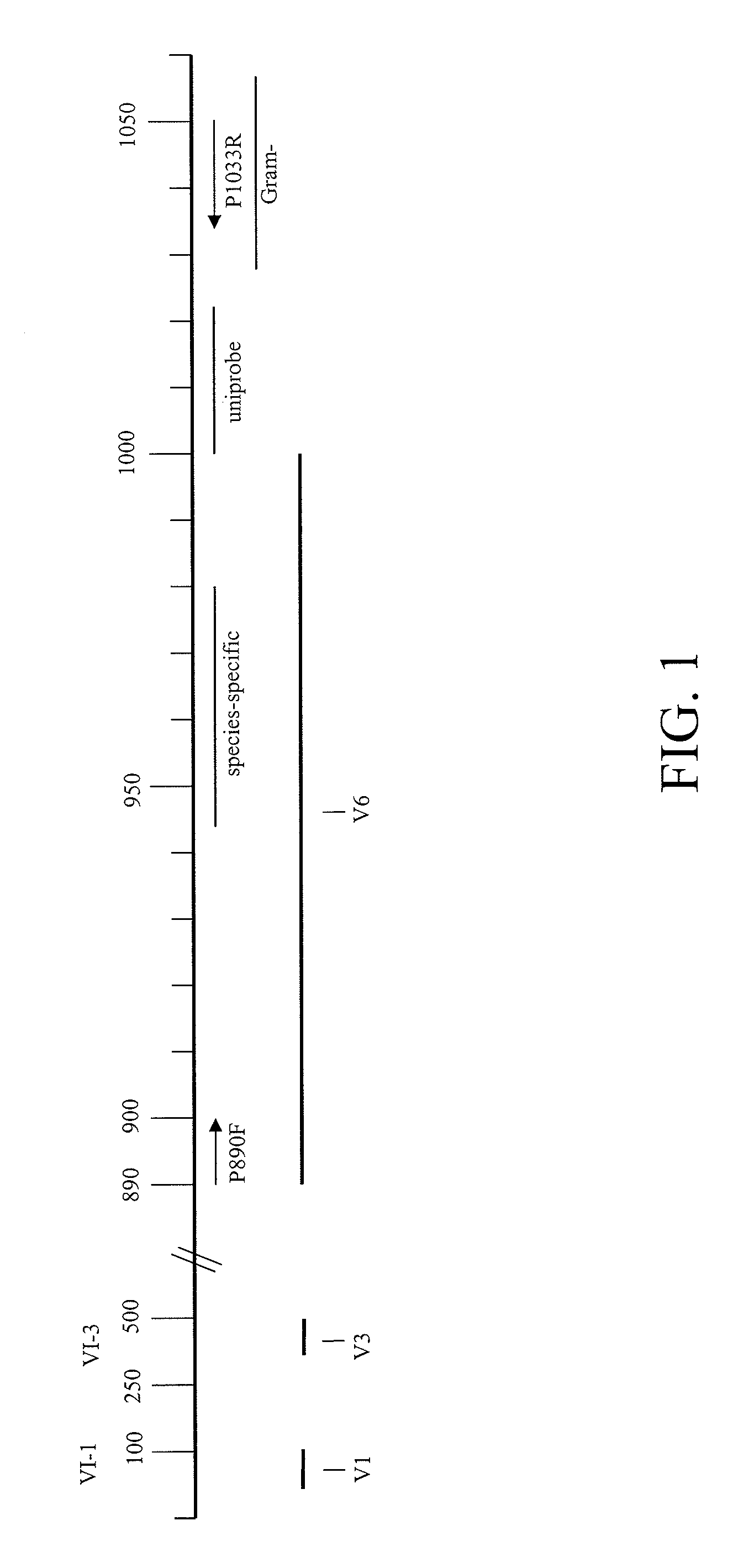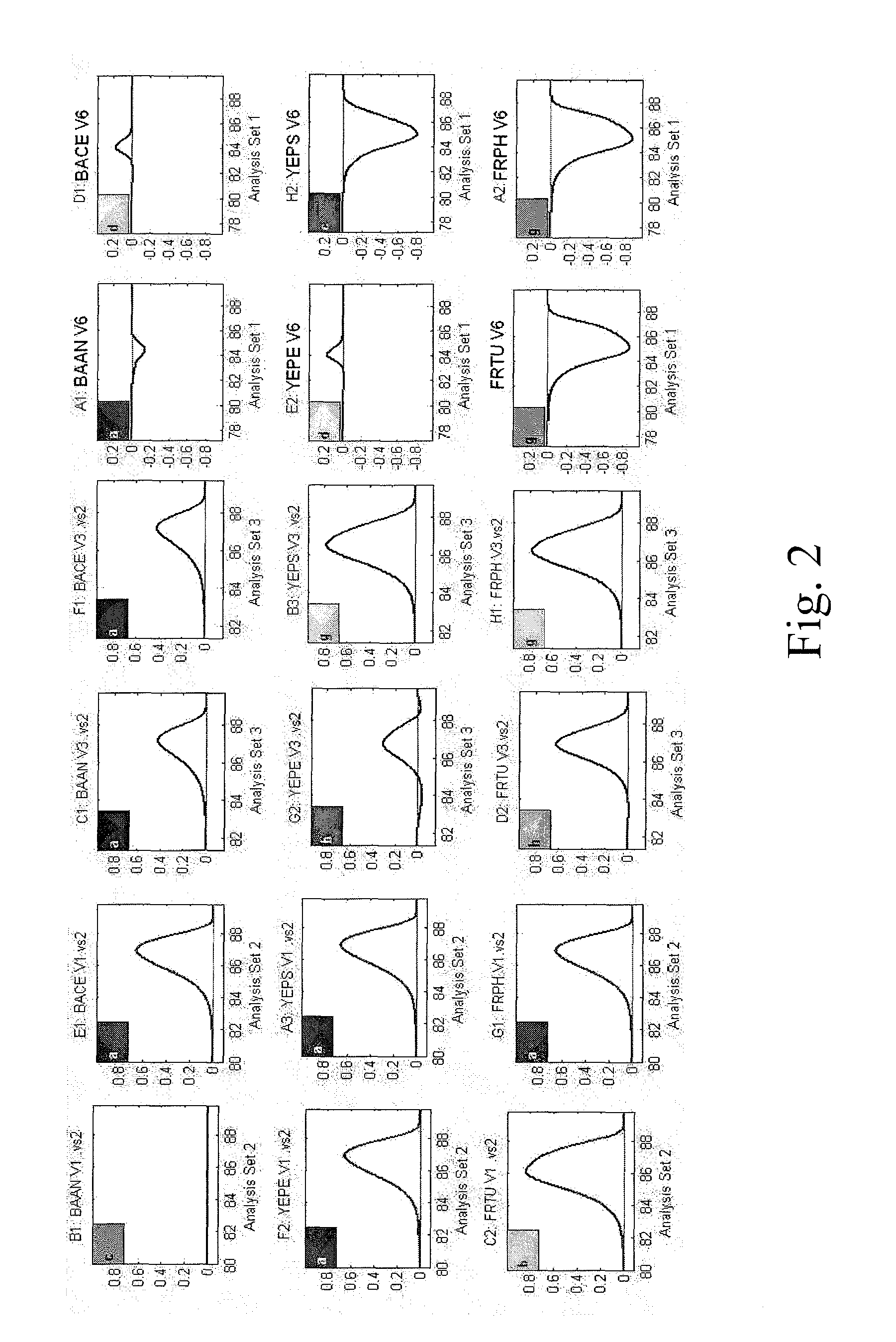Methods for Identifying Eubacteria
- Summary
- Abstract
- Description
- Claims
- Application Information
AI Technical Summary
Benefits of technology
Problems solved by technology
Method used
Image
Examples
example i
Rapid PCR-Based Diagnosis of Septic Arthritis by Early Gram-Type Classification and Species Identification
A. Materials and Methods
1. Bacterial Species and Mock-Up Samples
[0066]Thirty six clinically relevant bacterial organisms and DNA, including the six most common SA-related organisms, were obtained from American Type Culture Collection (ATCC, Manassas, Va.) or the Johns Hopkins Hospital (JHH) clinical laboratory (Division of Medical Microbiology, Johns Hopkins School of Medicine, Baltimore, Md.) (Table 1).
[0067]A single isolated colony of each organism was inoculated in Tryptic Soy Broth (TSB, Beckton and Dickinson, Sparks, Md.) and incubated at 37° C. overnight. For LOD (limit of detection) determination, serial dilutions of each SA related organisms were spiked into culture-negative and DNA free synovial fluid samples. These mockup samples were processed based on the protocol (“Extraction of DNA”) described below. LOD was calculated based on colony forming units per milliliter (...
example ii
Design of Gram-Negative and Gram-Positive Probes
[0094]To design probes that can distinguish between Gram positive and Gram negative bacteria, we aligned partial 16S rRNA sequences from within the universal PCR target region of various clinically relevant bacterial pathogens. The comparisons are shown in Table 7, below. In addition to SEQ ID NO:1 and SEQ ID NO:2, the sequences shown in table have SEQ ID NOs: 25 to 55, reading from top to bottom of the table.
Gram-Negative Sequence TGCTGCATGGCTGT (SEQ ID NO: 2)Acinetobacter spTTCGGG--AACTTACATACAGGTGCTGCATGGCTGTCGTCAGCTCGTGTpseudomonas_spTTCGGG--AACTCTGACACAGGTGCTGCATGGTTGTCGTCAGCTCGTGTAeromonas_caviaeTTCGGG--AATCAGAACACAGGTGCTGCATGGCTGTCGTCAGCTCGTGTAeromonas_hydrophilaTTCGGG--AATCAGAACACAGGTGCTGCATGGCTGTCGTCAGCTCGTGTKlebsiella pneumoniaeTTCGGG--AACTGTGAGACAGGTGCTGCATGGCTGTCGTCAGCTCGTGTSerratia_marcescensTTCGGG--AACTCTGAGACAGGTGCTGCATGGCTOTCGTCAGCTCGTGTEnterobacterTTCGGG--AACTCTGAGACAGGTGCTGCATGGCTGTCGTCAGCTCGTGTEs...
example iii
Rapid Identification of Class A Biothreat (“BT”) and Other Clinically Relevant Bacterial Species Using Universal PCR Coupled with High Resolution Melt Curve Profile Analysis
[0095]The inventors previously used the previously Uniprobe / species-specific RT-PCR assay to perform BT-surveillance and detection, using pathogen-specific TaqMan probes that were designed for Category A bacterial agents (Yang et al. (2008) Acted Emerg Med. 15, 388-9213). The assay demonstrated high analytical sensitivity, but was limited by inability to differentiate closely related pathogens due to decreased specificity of the TaqMan probe chemistry and high sequence homology within selected hypervariable region of the 16S rRNA gene. Probe-based amplicon characterization accordingly limits screening to a finite number of anticipated pathogens. Alternative strategies for amplicon analysis, such as sequencing and mass-spectrometry, allow broader scale product characterization but are costly, time-consuming, and l...
PUM
| Property | Measurement | Unit |
|---|---|---|
| Fraction | aaaaa | aaaaa |
| Electric charge | aaaaa | aaaaa |
| Electrical conductance | aaaaa | aaaaa |
Abstract
Description
Claims
Application Information
 Login to View More
Login to View More - R&D
- Intellectual Property
- Life Sciences
- Materials
- Tech Scout
- Unparalleled Data Quality
- Higher Quality Content
- 60% Fewer Hallucinations
Browse by: Latest US Patents, China's latest patents, Technical Efficacy Thesaurus, Application Domain, Technology Topic, Popular Technical Reports.
© 2025 PatSnap. All rights reserved.Legal|Privacy policy|Modern Slavery Act Transparency Statement|Sitemap|About US| Contact US: help@patsnap.com


